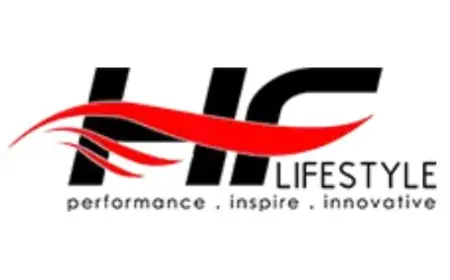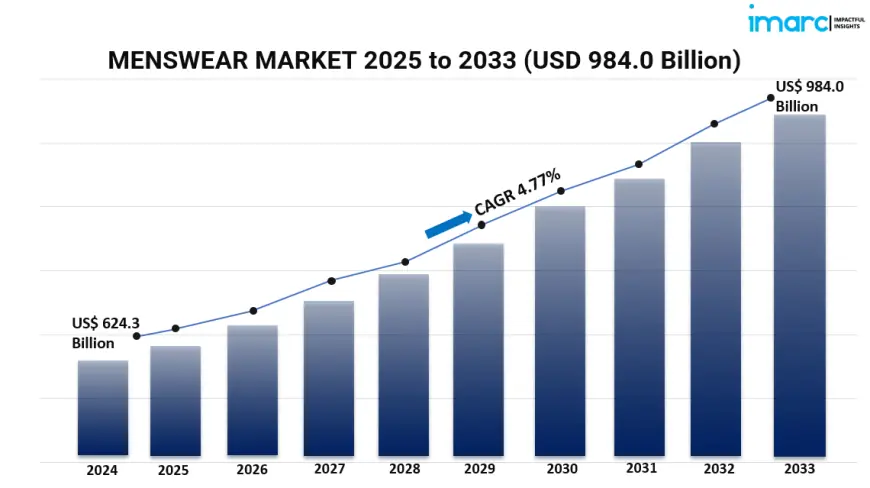Menswear Market: Global Industry Trends, Share, Size, Growth, and Forecast 2025-2033
The global menswear market is experiencing robust growth, reaching a valuation of USD 624.3 billion in 2024. Projections indicate a rise to USD 984.0 billion by 2033, reflecting a CAGR of 4.77% from 2025 to 2033. This expansion is driven by increasing fashion consciousness among men, the proliferation of e-commerce platforms, and the introduction of sustainable clothing options designed to prevent skin allergies.
Study Assumption Years:
-
Base Year: 2024
-
Historical Years: 2019-2024
-
Forecast Years: 2025-2033
Menswear Market Key Takeaways:
-
Market Size and Growth: The global menswear market was valued at USD 624.3 billion in 2024 and is projected to reach USD 984.0 billion by 2033, growing at a CAGR of 4.77% during 2025-2033.
-
Product Dominance: Shirts and T-shirts hold the largest market share, driven by their comfort and versatility, catering to both casual and formal wear needs.
-
Seasonal Preference: All-season wear dominates the market, reflecting consumer demand for versatile clothing suitable for various climates and occasions.
-
Distribution Channels: Exclusive stores lead in distribution, offering personalized services and premium products that enhance customer loyalty.
-
Regional Leadership: North America currently leads the market, attributed to a younger demographic and increased consumer spending power.
-
E-commerce Influence: The rise of online retail platforms has significantly contributed to market growth, providing consumers with a wide range of options and convenient shopping experiences.
-
Sustainability Trends: There is a growing demand for sustainable clothing produced from natural materials, aligning with consumer preferences for eco-friendly fashion choices.
Request for a sample copy of this report: https://www.imarcgroup.com/menswear-market/requestsample
Market Growth Factors:
1. Men's rising awareness of fashion : Men becoming more and more fashion-conscious is driving one of those periods of rising demand that is affecting the global menswear industry. More emphasis has been placed on fashion and grooming as a result of social media and fashion influencers' nowadays exposure of the term "personal image." Men today are driven to investigate different clothing choices across the whole spectrum in demand from casual to more official variants. This change in consumer behavior provides a stimulant for businesses to create new products to best match the shifting tastes and preferences of male consumers.
2. Growth of E-commerce Archives Over these years, the menswear market has evolved as e-commerce portals have emerged to provide consumer with ease of access to items from the other end of the virtual real. Online buying is appealing because of its great product range, literally return policies, and competitive pricing options. Along with aggressive marketing approaches and tailored suggestions, the convenience element related with online shopping has much improved the general customer shopping experience, therefore boosting market sales and general expansion.
3. Value of Eco-Friendly and Sustainable Clothing : The menswear sector is starting to see a trend toward environmentally friendly fabrics and sustainability. Natural and organic materials that our planet might regard as friendly and our skins find acceptable are now favored by consumers. Manufacturers have had to adopt organic fabrics and ecologically friendly production processes as part of their sustainable practices in response to this demand. Therefore, sustainability extends to uphold the future development and resiliency of the menswear sectors rather than just satisfy consumer expectations.
Market Segmentation:
Breakup by Product Type:
-
Trousers: Essential lower-body garments suitable for both formal and casual occasions, offering versatility in men's wardrobes.
-
Denims: Durable and stylish jeans that are a staple in casual wear, known for their comfort and adaptability.
-
Shirts and T-Shirts: Core upper-body clothing items that provide comfort and style, suitable for various settings and preferences.
-
Ethnic Wear: Traditional attire reflecting cultural heritage, often worn during festivals, weddings, and other ceremonial events.
-
Others: Includes a variety of men's clothing items such as jackets, suits, and accessories that complement the main wardrobe.
Breakup by Season:
-
Summer Wear: Lightweight and breathable clothing designed to provide comfort during hot weather conditions.
-
Winter Wear: Insulated and warm garments intended to protect against cold climates, including coats and thermal wear.
-
All-Season Wear: Versatile clothing suitable for year-round use, offering adaptability to changing weather conditions.
Breakup by Distribution Channel:
-
Supermarkets and Hypermarkets: Large retail outlets offering a wide range of menswear products, providing convenience and variety to consumers.
-
Exclusive Stores: Brand-specific retail stores that offer personalized shopping experiences and exclusive product lines.
-
Multi-Brand Retail Outlets: Stores that house multiple brands under one roof, giving consumers diverse choices in one location.
-
Online Stores: E-commerce platforms that provide easy access to a broad selection of menswear, enabling shopping from the comfort of home.
-
Others: Includes alternative retail channels such as pop-up shops, catalogs, and direct-to-consumer sales.
Breakup by Region:
-
North America (United States, Canada)
-
Asia Pacific (China, Japan, India, South Korea, Australia, Indonesia, Others)
-
Europe (Germany, France, United Kingdom, Italy, Spain, Russia, Others)
-
Latin America (Brazil, Mexico, Others)
-
Middle East and Africa
Regional Insights:
North America currently dominates the global menswear market, driven by a younger demographic and increased consumer spending power. The region's fashion-forward population and the presence of established brands contribute to its leading position.
Recent Developments & News:
The menswear industry is witnessing significant advancements, particularly in the United States. In July 2024, Pacsun launched the versatile A.R.C. (Active. Recreation. Comfort.) collection, catering to the growing demand for multifunctional sportswear that combines comfort and utility. Similarly, in May 2024, Macy's introduced a unique menswear line featuring blazers, polos, and cardigans designed for adaptability across various occasions. These developments reflect the industry's shift towards performance-driven, sustainable, and technologically advanced clothing options that meet the evolving preferences of modern consumers.
Key Players:
-
Adidas AG
-
Burberry Group Plc
-
Gap Inc
-
Giorgio Armani S.p.A
-
H&M Hennes & Mauritz AB
-
Kering S.A.
-
Levi Strauss & Co.
-
Nike Inc.
-
Prada S.p.A.
-
PVH Corp.
-
Ralph Lauren Corporation
-
Zara S.A. (Industria de Diseño Textil, S.A.)
If you require any specific information that is not covered currently within the scope of the report, we will provide the same as a part of the customization.
Ask Analyst for Customization: https://www.imarcgroup.com/request?type=report&id=2259&flag=C
About Us:
IMARC Group is a global management consulting firm that helps the world’s most ambitious changemakers to create a lasting impact. The company provides a comprehensive suite of market entry and expansion services. IMARC offerings include thorough market assessment, feasibility studies, company incorporation assistance, factory setup support, regulatory approvals and licensing navigation, branding, marketing and sales strategies, competitive landscape and benchmarking analyses, pricing and cost research, and procurement research.
What's Your Reaction?
 Like
0
Like
0
 Dislike
0
Dislike
0
 Love
0
Love
0
 Funny
0
Funny
0
 Angry
0
Angry
0
 Sad
0
Sad
0
 Wow
0
Wow
0




















































